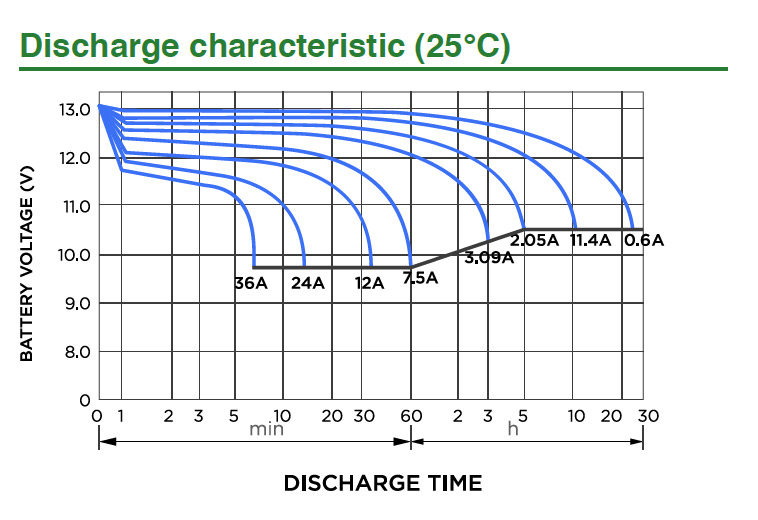Ah, Ampere Hour or Amp Hour all describe the same characteristic of a battery – how long it will last when connected to the item it is powering. This is often referred to as the ‘capacity‘ of a battery.
The measurement is often misunderstood as, for example, “a 5Ah battery will power a 5 amp device for one hour”. This is wrong.
The Amp Hour rating means nothing on its own unless you also know:
- The temperature of the environment that the battery was tested in
- The ‘hour rate’ that was used
- What the battery powered
- The end voltage (As a battery discharges its voltage also reduces – see Battery Glossary – Voltage for the detail)
On a good quality battery you will always find this on the product or in the accompanying technical specification sheet. A 6 volt 4 Ah sealed lead acid battery specification might look like this:
| Capacity 77°F (25°C) | 20 hour rate (0.2A, 5.25V) | 4.0 Ah |
| 5 hour rate (0.7A, 5.25V) | 3.5 Ah | |
| 1 hour rate (2.5A, 4.8V) | 2.5 Ah |
What does that all mean? Lets take it apart.
First we are told the temperature of the environment in which the battery was tested. This is important because batteries perform better at room temperature that in very hot or very cold environments. A battery with the same data as we can see above that was tested at 41°F (5°C) would be a better battery as it could provide the same capacity, but in conditions hostile to its design.
- The first row of the table tells us this battery can power a 0.2 amp appliance for 20 hours. After this time it will have a voltage 5.25 and a capacity of 4.0Ah. This is the industry average ’20 hour’ rating.
- The second row tells us the battery can power a 0.7 amp appliance for 5 hours. After this time it will have a voltage of 5.25 and capacity of 3.5 Ah
- The third row tells us the battery can power a 2.5 amp appliance for 1 hour. After this time it will have a voltage of 4.8 and a capacity of 2.5 Ah
Sometimes manufacturers may prefer to display the data slightly differently by stating how long it takes the battery to go from, for example, a fully charged 12 volts to 10.5 volts under different rates of discharge. The first row of the table above could also be written as:
“4.0 Ah @ 20 hour rate to 5.25 volts“
How do you calculate capacity?
Dividing the Amp Hour figure by the ‘hour rate’ will tell you what device the battery can power for that time period.
Amp Hour / Hour Rate = Amp of Device
So, as we’ve seen above, a 4 Ah battery using the 20 hour rate gives us:
4 Ah / 20 Hour Rate = 0.2 Amp Device
The relationship between the devices amperage and how long the battery will last do not make a straight line on a graph. If we connected this 4 Ah battery to a 0.4 Amp device (twice the drain of a 0.2 amp device in the example above) it would actually last around nine hours, not ten as might be expected. Double the device demands again to 0.8 amps and the discharge time doesn’t decrease to four and a half, but to four hours.
The main reason behind this is that most batteries don’t like discharging fast. The greater the rate of discharge, the greater the internal resistance inside the battery which wastes energy via heat and shortens the time that the battery can power the device.
Calculating the actual expected life of a battery in any given situation can be done with the Peukert’s Law calculator. Most good quality batteries will also come with a technical specification sheet which also includes a graph like the one below.

We can see here that when connected to a 12 amp device the battery will last about 40 minutes before the voltage drops below 10, at which point the device will probably cut off. Not the one hour that many people believe.
Note some graphs use ‘C’ instead of ‘A’. C is Ah but as amperage. So for a 12Ah battery 1C = 12 amps. In the graph above we would replace 12A with 1C, 24A with 2C and 36A with 3C.
Buyer Beware
The industry standard ‘hour rate’ is 20, but that doesn’t mean all manufacturers follow it. A manufacturer that decides to use a 10 hour rate will produce a highly inferior 4 ah battery, so always insist on seeing the technical specification sheet before you buy.
See Which deep cycle AH battery for more on this and other ways you can be mislead.
It is also important to be aware that batteries degrade as they get older (calendar life) and the more they are used (cycle life). A brand new 4Ah battery might be able to power a 0.2 amp appliance for 20 hours, but one that has been discharged and recharged many times will last a shorter period.


I have 8 12 volt batterys .in need 48 volts .each battery is 110 ah .what method shuold I use to maximize the ah of the batterys
I have 8 x 12 volt batterys deep charge .I need 48 volts with maximum amper hour
The batterys are rated at 110 amper hours?
2- 6 v bat. at 225ah ea. a fridge running at 6.5 amp will run how long off of 2000w inverter rv motorhome charging the batteries? I cant finger this out if it will work .
I am trying to find out the best 6 volt spring top battery for a deer feeder. In the winter it could be freezing and in the summer it could be 100 degrees. How about the Duracell Ultra 6 Volt 13Ah battery?
The entire article was very helpful for newbie like me. I do have 2 questions.
1. “The first row of the table – 20 hour rate (0.2A, 5.25V) 4.0 Ah – tells us this battery can power a 0.2 amp appliance for 20 hours. After this time it will have a voltage 5.25 and a capacity of 4.0Ah.”
How to interpret “after this time it will have …”? My understanding is, after 20 hours, the REMAINING voltage will drop to 5.25, but the REMAINING capacity does NOT have 4Ah. Rather, the ALREADY-consumed “amount of electricity” had been 4Ah at that point. Is it correct?
2. “The industry standard ‘hour rate’ is 20, … A manufacturer that decides to use a 5 hour rate will produce a highly inferior 4 ah battery”.
Why so? The same battery in this article would be rated as 4.0 Ah at 20 hour rate, or can be rated as 3.5 Ah at 5 hour rate. But if a manufacturer would produce a battery that can output 4 Ah at 5 hour rate (i.e. 0.8A * 5h), isn’t that battery better than our benchmark 3.5 Ah at same 5 hour rate?
I’m curious about Delco 6V lead acid batteries used in vintage cars. The 100 AH battery was 15AA6-W with 15 plates. They also used a 90 AH battery. I don’t have the number for that one. But I’m wondering what construction or size difference would there be between a 90 AH and a 100 AH battery?
I’m trying to find a US-made 12-volt battery that will work with a Flower Turbines wind generator. I’m not that knowledgeable about electronics. I saw a Dakota 100h battery and I’m trying to figure out if that would work. They’re very expensive though but I’m trying to stay away from ones made in China. Any help would be appreciated. (I’m a 76-year-old woman who would love to be off-grid eventually but not right this minute. Thanks.)